1. Graber TM, Rakosi T, Petrovic AG. Dentofacial orthopedics with functional appliances. 2nd ed. St. Louis: Mosby;1997.
2. Suhr CH, Nahm DS, Chang YI. Epidemiologic study of the prevalence of malocclusion in Korean. Korean J Orthod. 1984; 14:33–37.
3. Kang HK, Ryu YK. A study on the prevalence of malocclusion of Yonsei University students in 1991. Korean J Orthod. 1992; 22:691–701.
4. Miyajima K, McNamara JA Jr, Sana M, Murata S. An estimation of craniofacial growth in the untreated Class III female with anterior crossbite. Am J Orthod Dentofacial Orthop. 1997; 112:425–434. PMID:
9345155.

5. Yang WS. The study on the orthodontic patients who visited Department of Orthodontics, Seoul National University Hospital during last 10 years (1985-1994). Korean J Orthod. 1995; 25:497–509.
6. Yu HS, Ryu YK, Lee JY. A study on the distributions and trends in malocclusion patients from department of orthodontics, college of dentistry, Yonsei university. Korean J Orthod. 1999; 29:267–276.
7. Hwang MS, Yoon YJ, Kim KW. An epidemiologic study on the orthodontic patients who visited Department of Orthodontics, Chosun University Dental Hospital last 10 years (1990-1999). Korean J Orthod. 2001; 31:283–300.
8. Son MH, Chang YI. Evaluation of various cephalometric measurements to predict the prognosis of early Class III malocclusion treatment. Korean J Orthod. 2004; 34:205–218.
9. Seehra J, Fleming PS, Mandall N, Dibiase AT. A comparison of two different techniques for early correction of Class III malocclusion. Angle Orthod. 2012; 82:96–101. PMID:
21806467.

10. Chen L, Chen R, Yang Y, Ji G, Shen G. The effects of maxillary protraction and its long-term stability--a clinical trial in Chinese adolescents. Eur J Orthod. 2012; 34:88–95. PMID:
21325335.

11. Morales-Fernández M, Iglesias-Linares A, Yañez-Vico RM, Mendoza-Mendoza A, Solano-Reina E. Boneand dentoalveolar-anchored dentofacial orthopedics for Class III malocclusion: new approaches, similar objectives?: a systematic review. Angle Orthod. 2013; 83:540–552. PMID:
23621558.
12. Proffit WR, Fields HW, Sarver DM. Contemporary orthodontics. 5th ed. St. Louis: Mosby;2013.
13. Esenlik E, Cahide A, Gayem EA, Yavuz F. Maxillary protraction using skeletal anchorage and intermaxillary elastics in Skeletal Class III patients. Korean J Orthod. 2015; 45:95–101. PMID:
25798416.

14. Garattini G, Levrini L, Crozzoli P, Levrini A. Skeletal and dental modifications produced by the Bionator III appliance. Am J Orthod Dentofacial Orthop. 1998; 114:40–44. PMID:
9674678.

15. Arman A, Toygar TU, Abuhijleh E. Profile changes associated with different orthopedic treatment approaches in Class III malocclusions. Angle Orthod. 2004; 74:733–740. PMID:
15673133.
16. Abdelnaby YL, Nassar EA. Chin cup effects using two different force magnitudes in the management of Class III malocclusions. Angle Orthod. 2010; 80:957–962. PMID:
20578869.

17. Liu ZP, Li CJ, Hu HK, Chen JW, Li F, Zou SJ. Efficacy of short-term chincup therapy for mandibular growth retardation in Class III malocclusion. Angle Orthod. 2011; 81:162–168. PMID:
20936970.

18. Sugawara J, Aymach Z, Hin H, Nanda R. One-phase vs 2-phase treatment for developing Class III malocclusion: a comparison of identical twins. Am J Orthod Dentofacial Orthop. 2012; 141:e11–e22. PMID:
22196197.

19. Souki BQ, Figueiredo DS, Lima IL, Oliveira DD, Miguel JA. Two-phase orthodontic treatment of a complex malocclusion: giving up efficiency in favor of effectiveness, quality of life, and functional rehabilitation. Am J Orthod Dentofacial Orthop. 2013; 143:547–558. PMID:
23561417.

20. Satravaha S, Taweesedt N. Stability of skeletal changes after activator treatment of patients with class III malocclusions. Am J Orthod Dentofacial Orthop. 1999; 116:196–206. PMID:
10434094.

21. Levin AS, McNamara JA Jr, Franchi L, Baccetti T, Fränkel C. Short-term and long-term treatment outcomes with the FR-3 appliance of Fränkel. Am J Orthod Dentofacial Orthop. 2008; 134:513–524. PMID:
18929269.

22. Lim JH, Nahm DS, Yang WS, Suh CH. A case report of mandibular prognathism treated with activatior. Korean J Orthod. 1976; 6:79–82.
23. Chun YS. Clinical considerations on the effect of the Wunderer activator for correction of anterior cross bite. Taehan Chikkwa Uisa Hyophoe Chi. 1986; 24:1049–1060. PMID:
3474311.
24. Pak HS, Jung HS, Jung HM. Treatment of mandibular prognathism with activator; case report. J Korean Acad Pediatr Dent. 1989; 16:125–131.
25. Pak CJ, Kim HJ, Nam SH. A comparison of the functional orthopedic appliances in the treatment of functonal anterior crossbite. J Korean Acad Pediatr Dent. 1995; 22:111–127.
26. Baccetti T, Franchi L, McNamara JA Jr. The cervical vertebral maturation (CVM) method for the assessment of optimal treatment timing in dentofacial orthopedics. Semin Orthod. 2005; 11:119–129.

27. Bruntz LQ, Palomo JM, Baden S, Hans MG. A comparison of scanned lateral cephalograms with corresponding original radiographs. Am J Orthod Dentofacial Orthop. 2006; 130:340–348. PMID:
16979492.

28. O'Reilly MT, Yanniello GJ. Mandibular growth changes and maturation of cervical vertebrae--a longitudinal cephalometric study. Angle Orthod. 1988; 58:179–184. PMID:
3164596.
29. Franchi L, Baccetti T, McNamara JA Jr. Mandibular growth as related to cervical vertebral maturation and body height. Am J Orthod Dentofacial Orthop. 2000; 118:335–340. PMID:
10982936.

30. Kuc-Michalska M, Baccetti T. Duration of the pubertal peak in skeletal Class I and Class III subjects. Angle Orthod. 2010; 80:54–57. PMID:
19852640.

31. Kim SJ, Kim KH, Yu HS, Baik HS. Dentoalveolar compensation according to skeletal discrepancy and overjet in skeletal Class III patients. Am J Orthod Dentofacial Orthop. 2014; 145:317–324. PMID:
24582023.



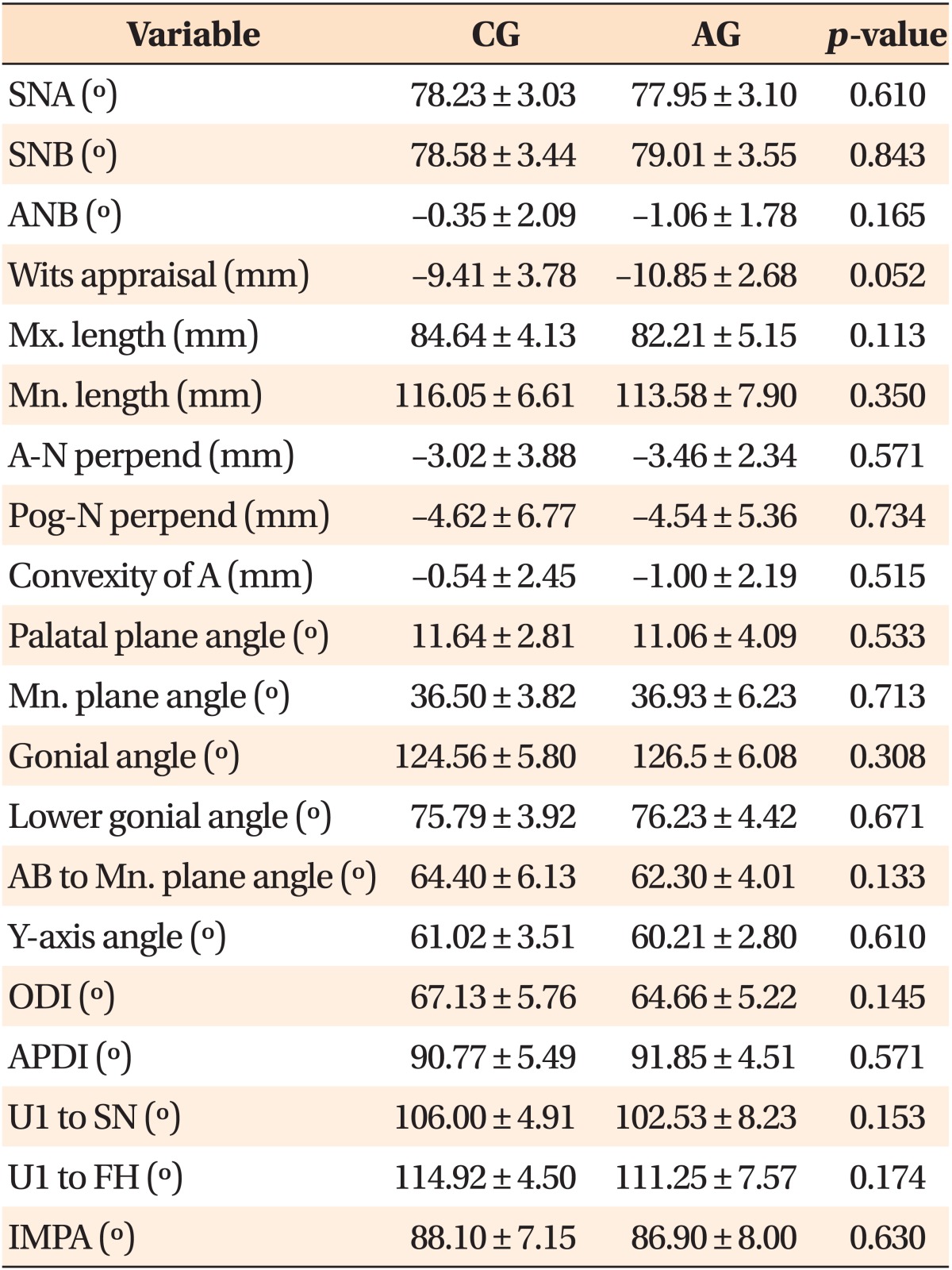
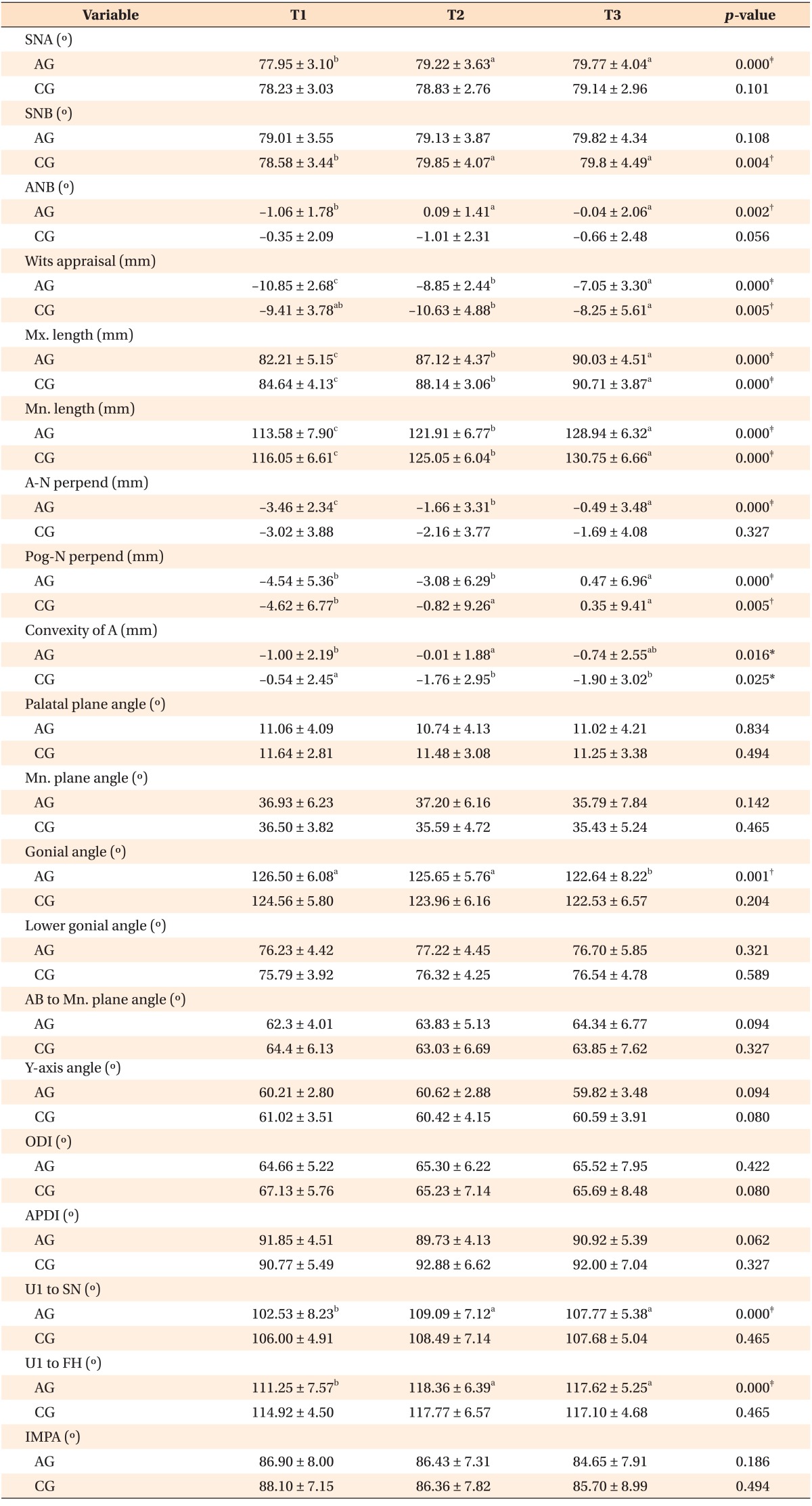
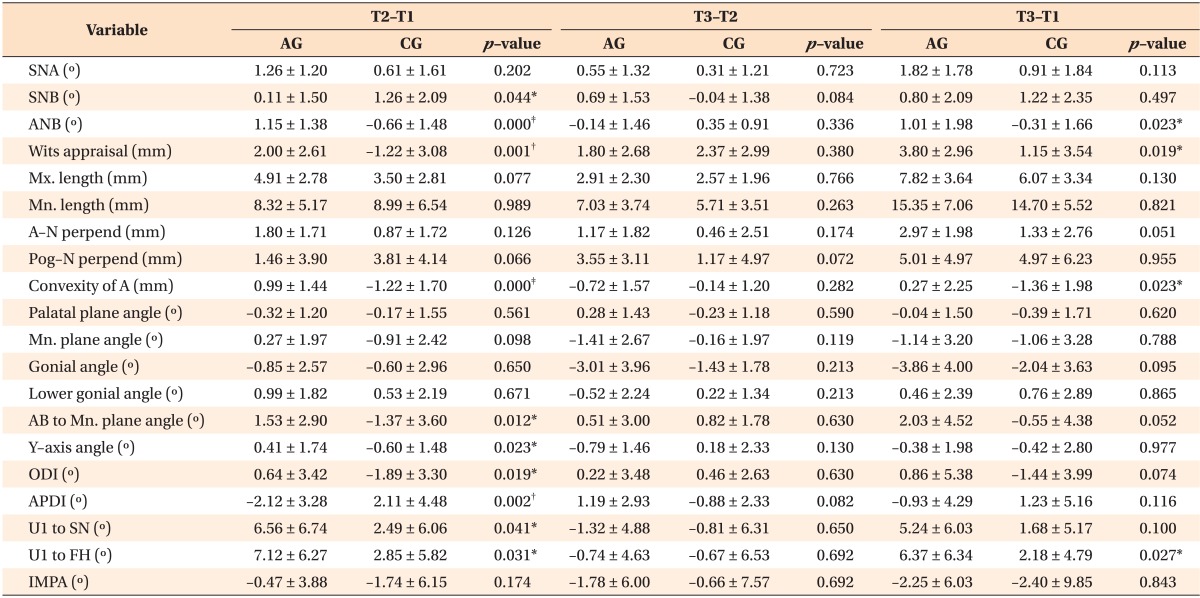




 PDF
PDF ePub
ePub Citation
Citation Print
Print


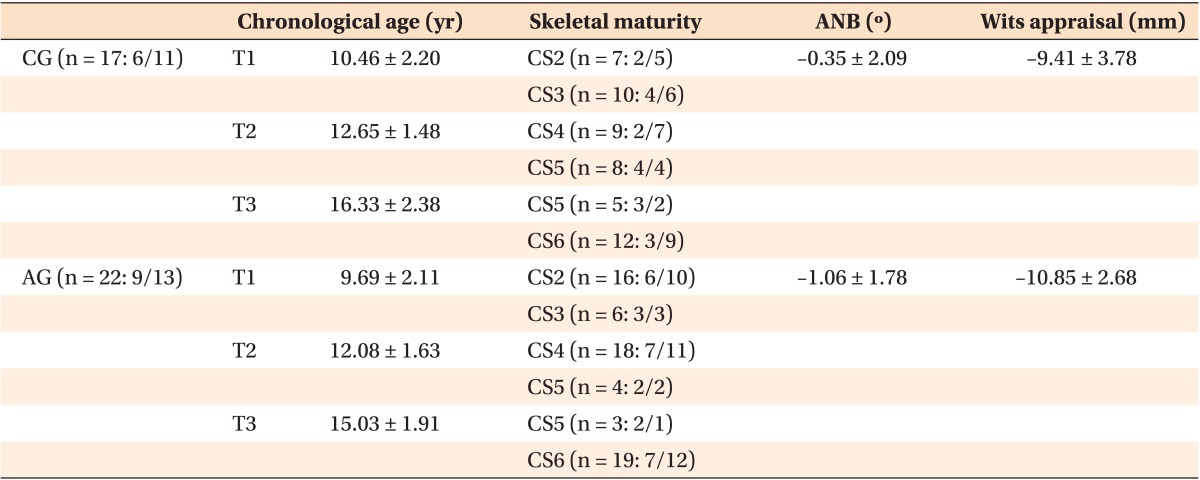
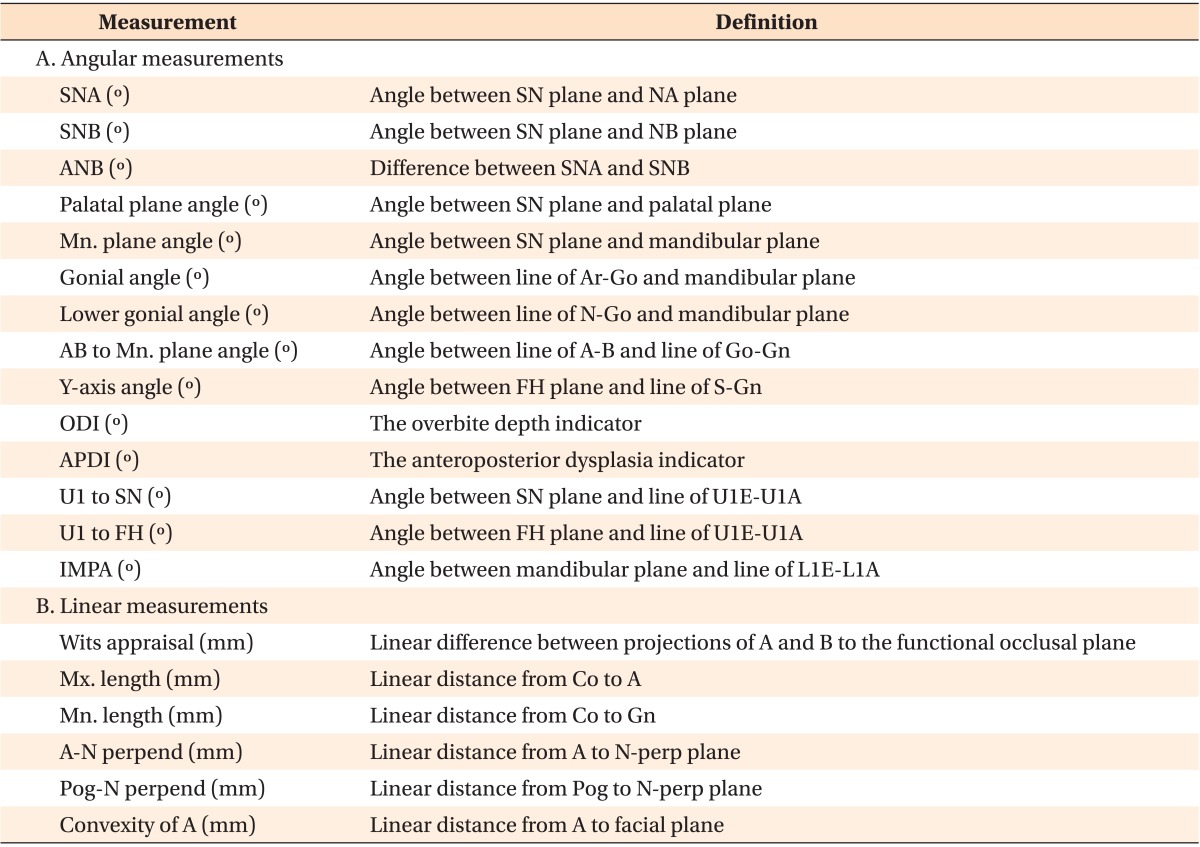
 XML Download
XML Download